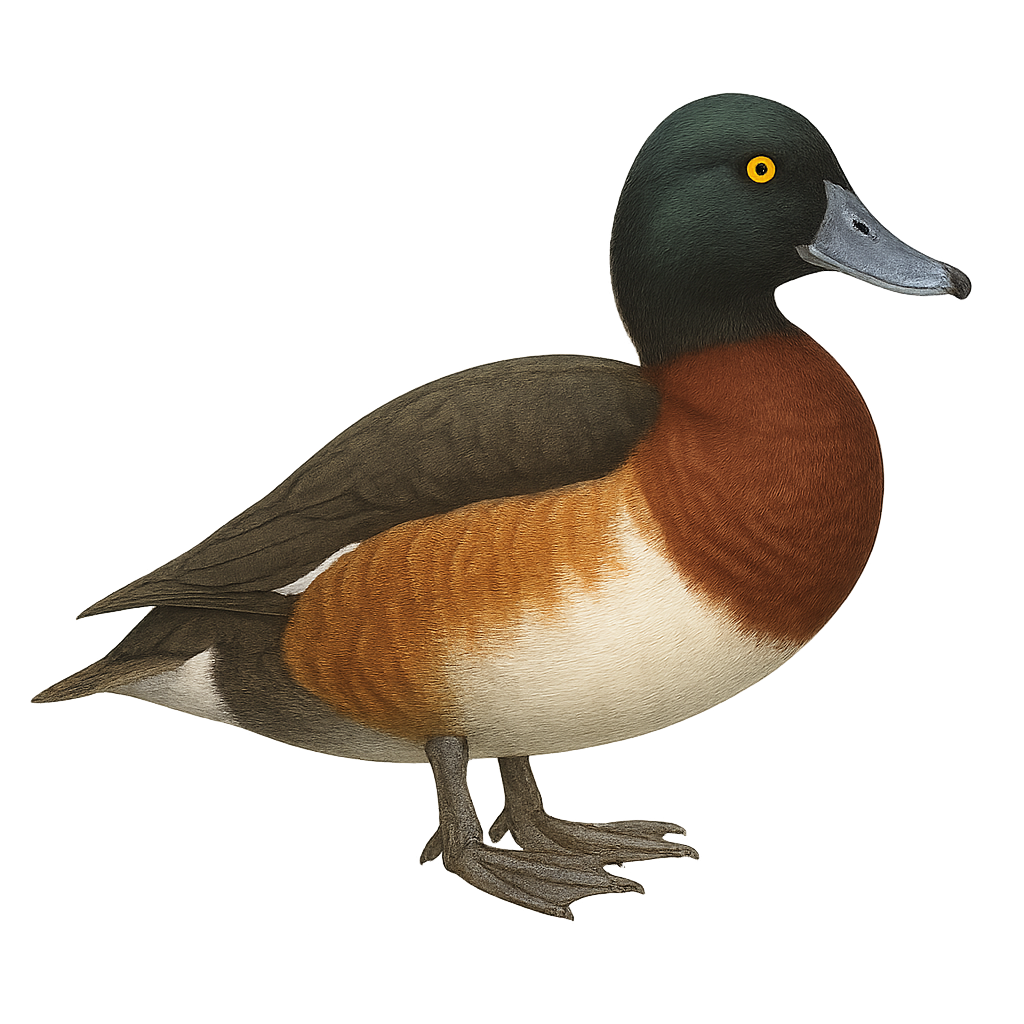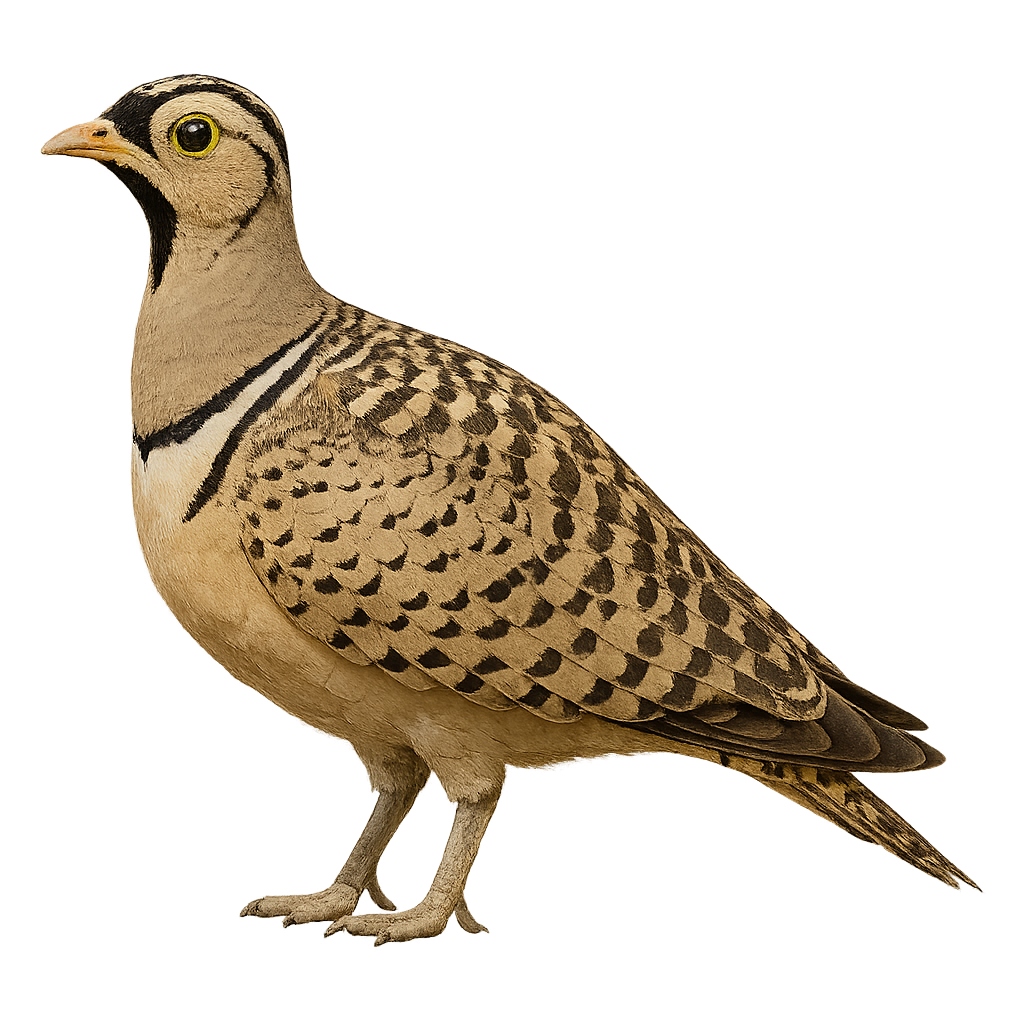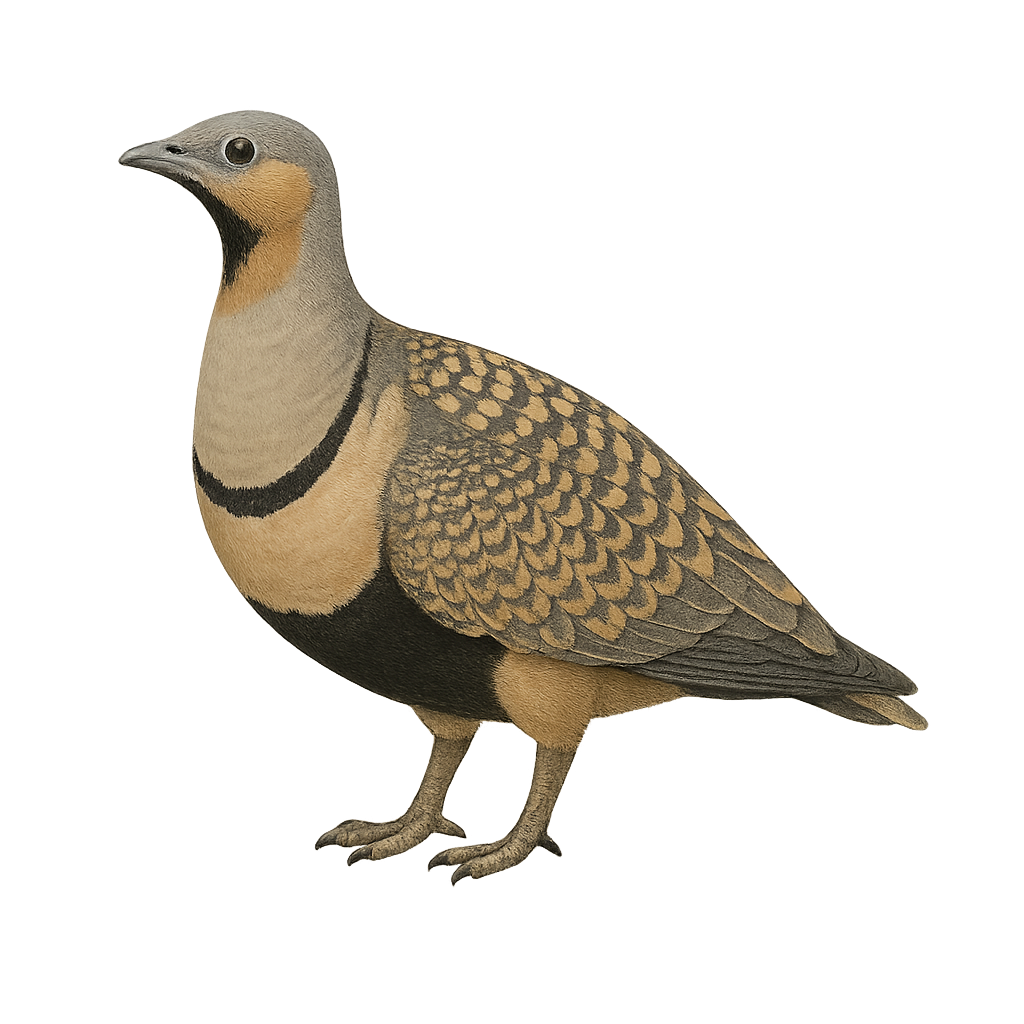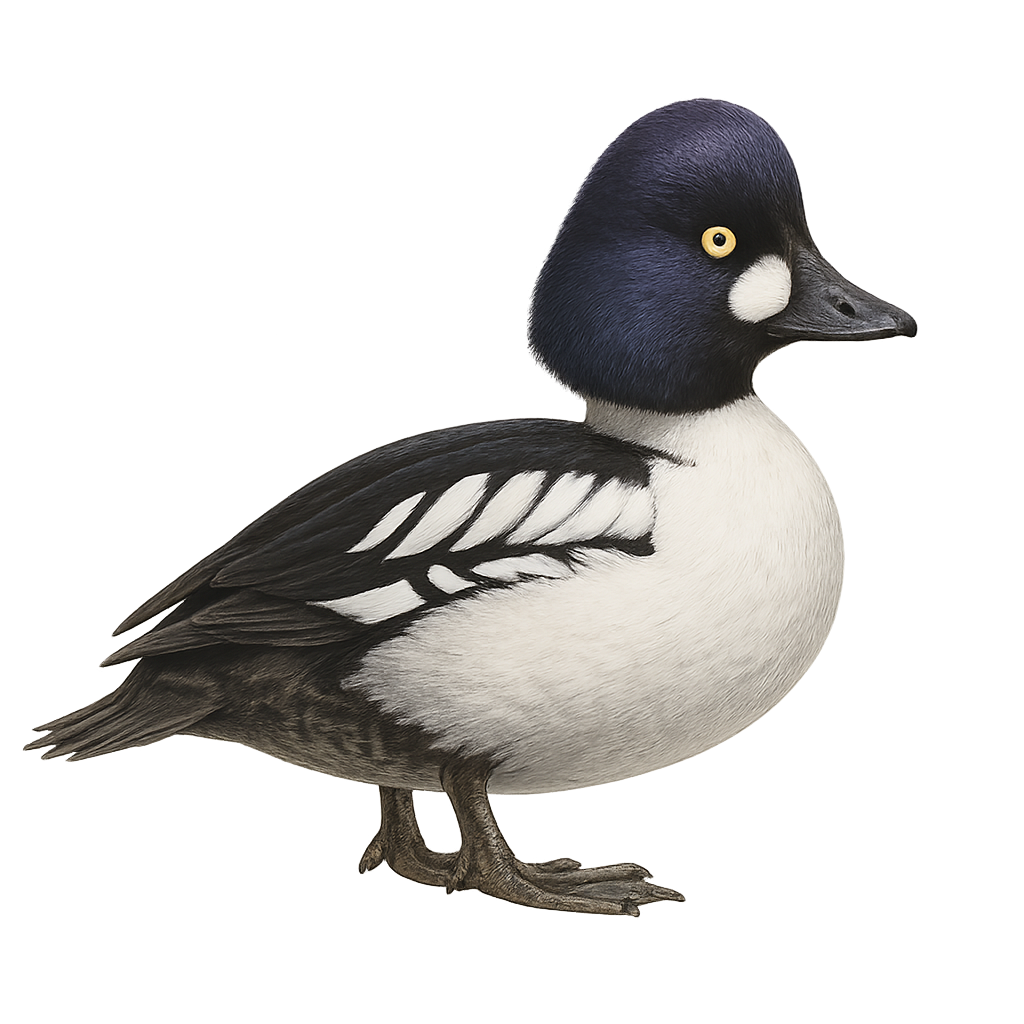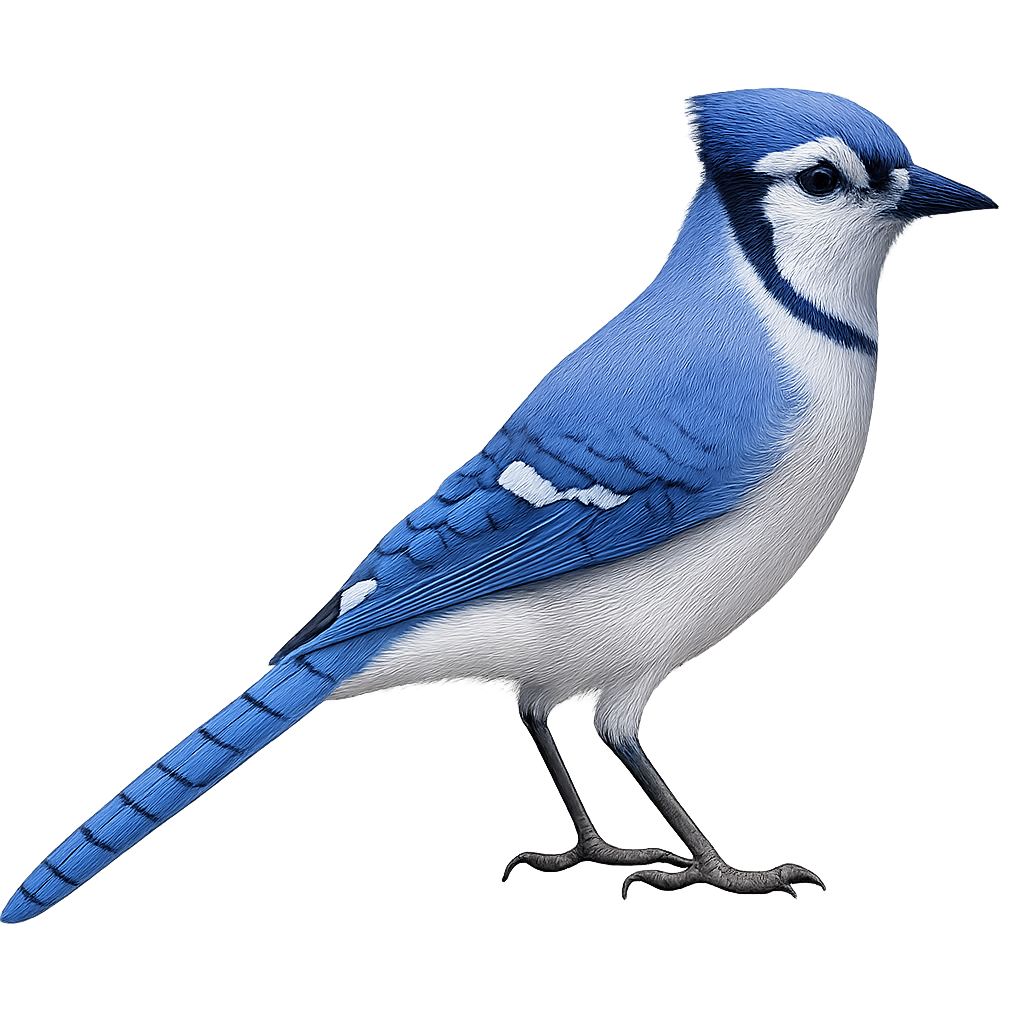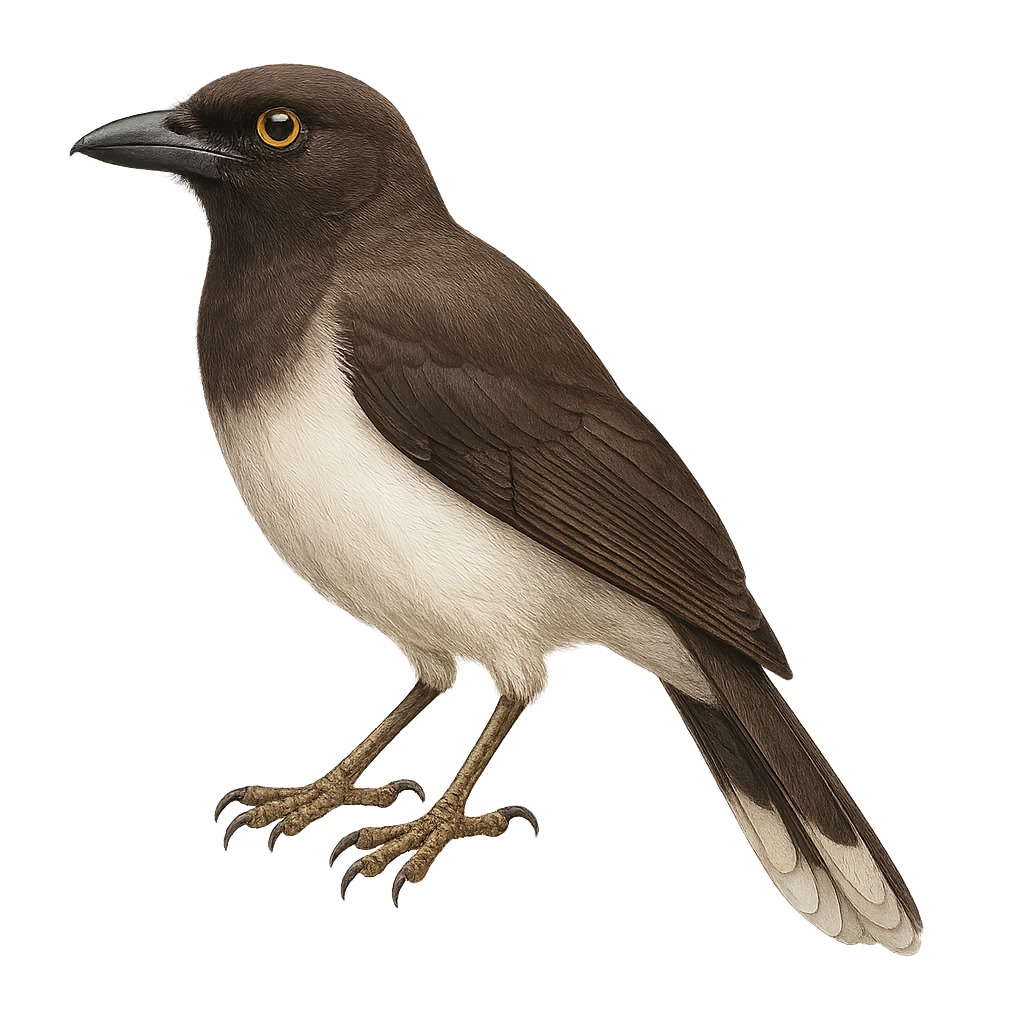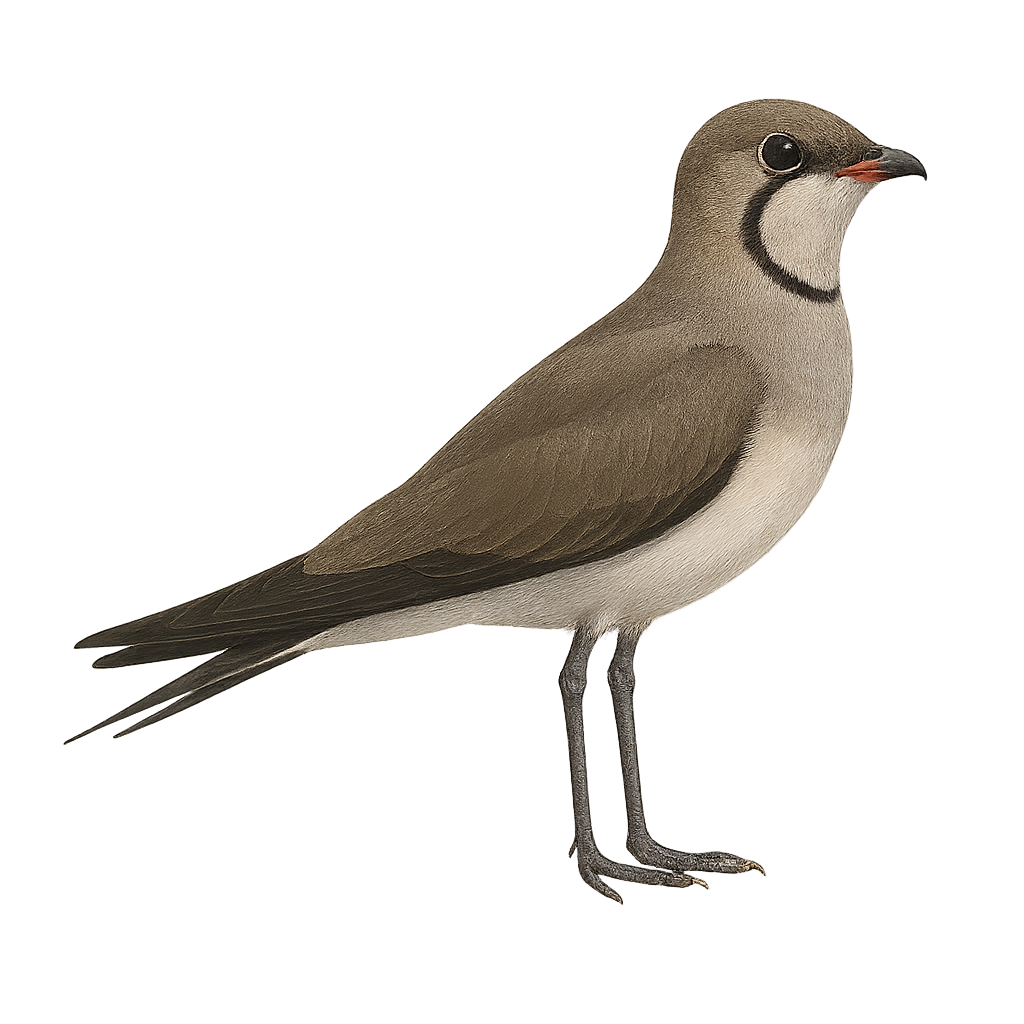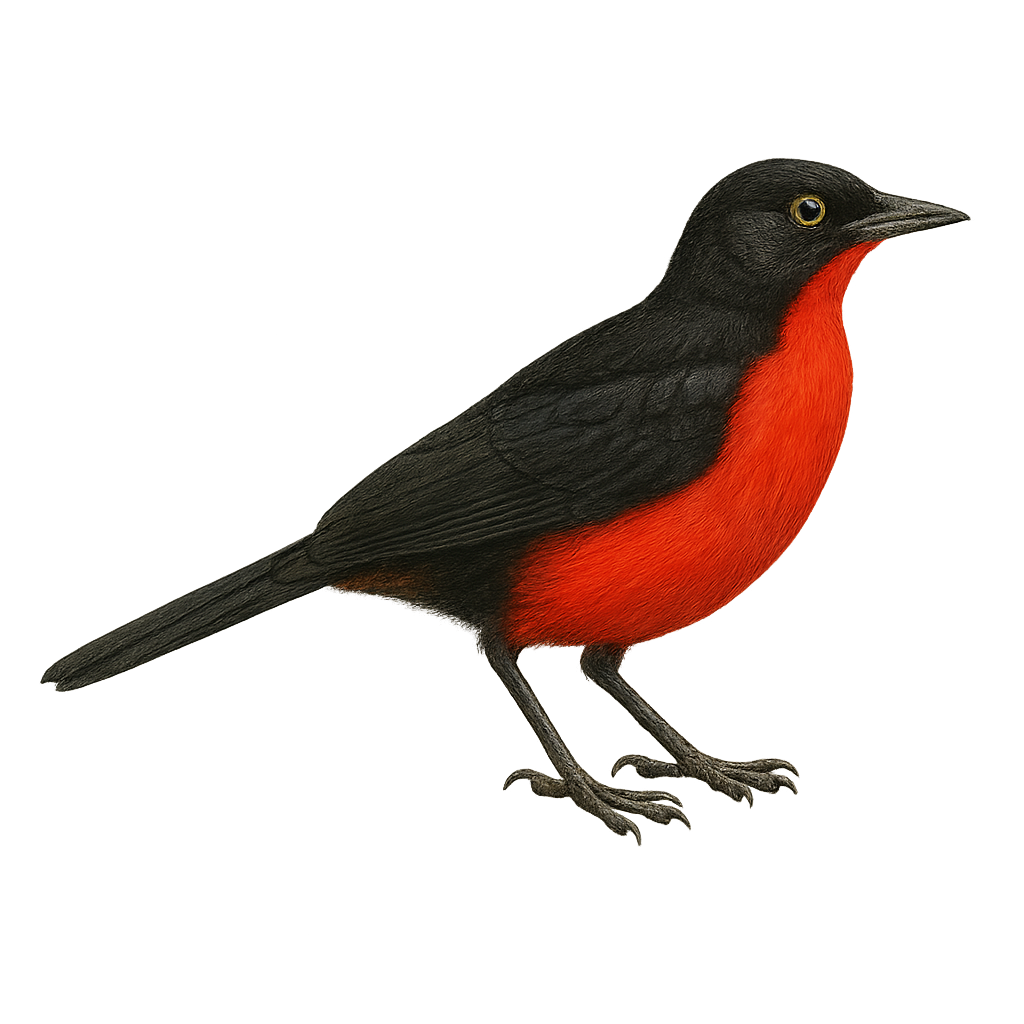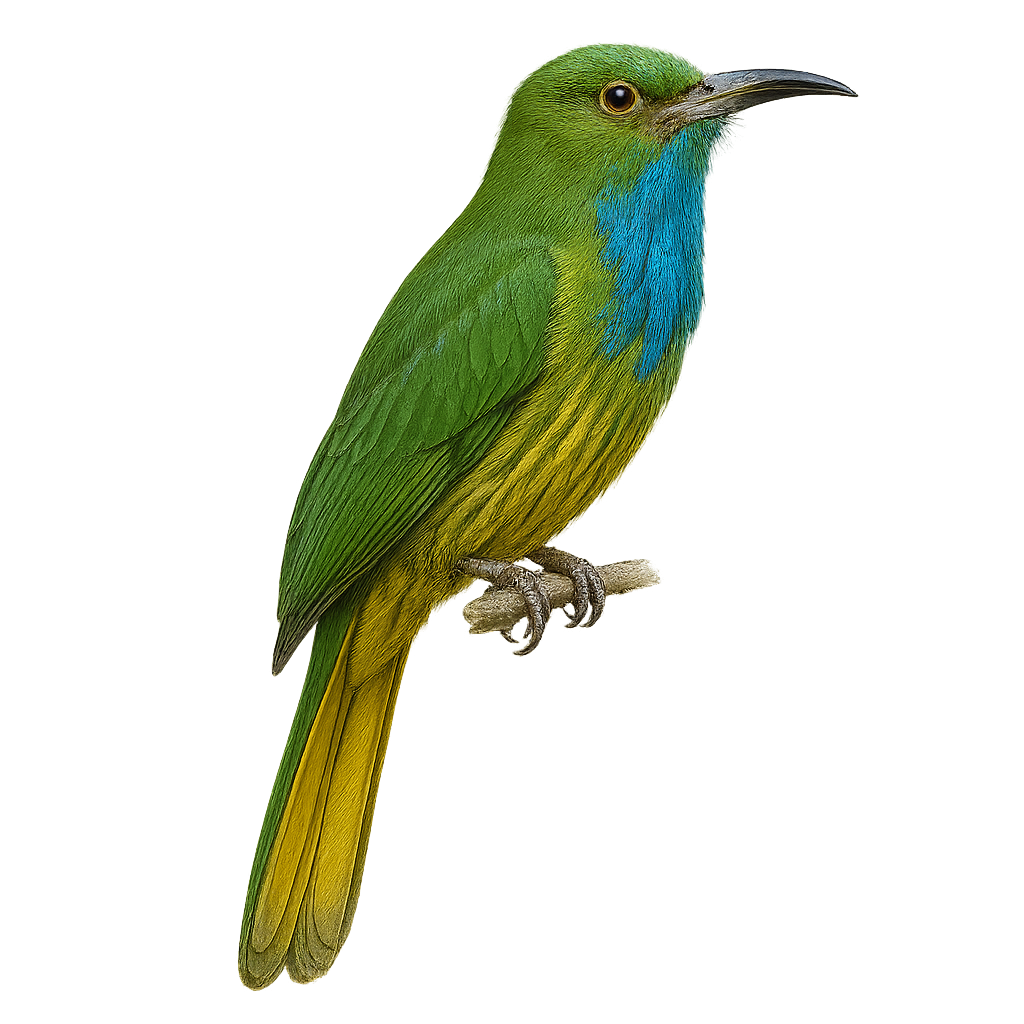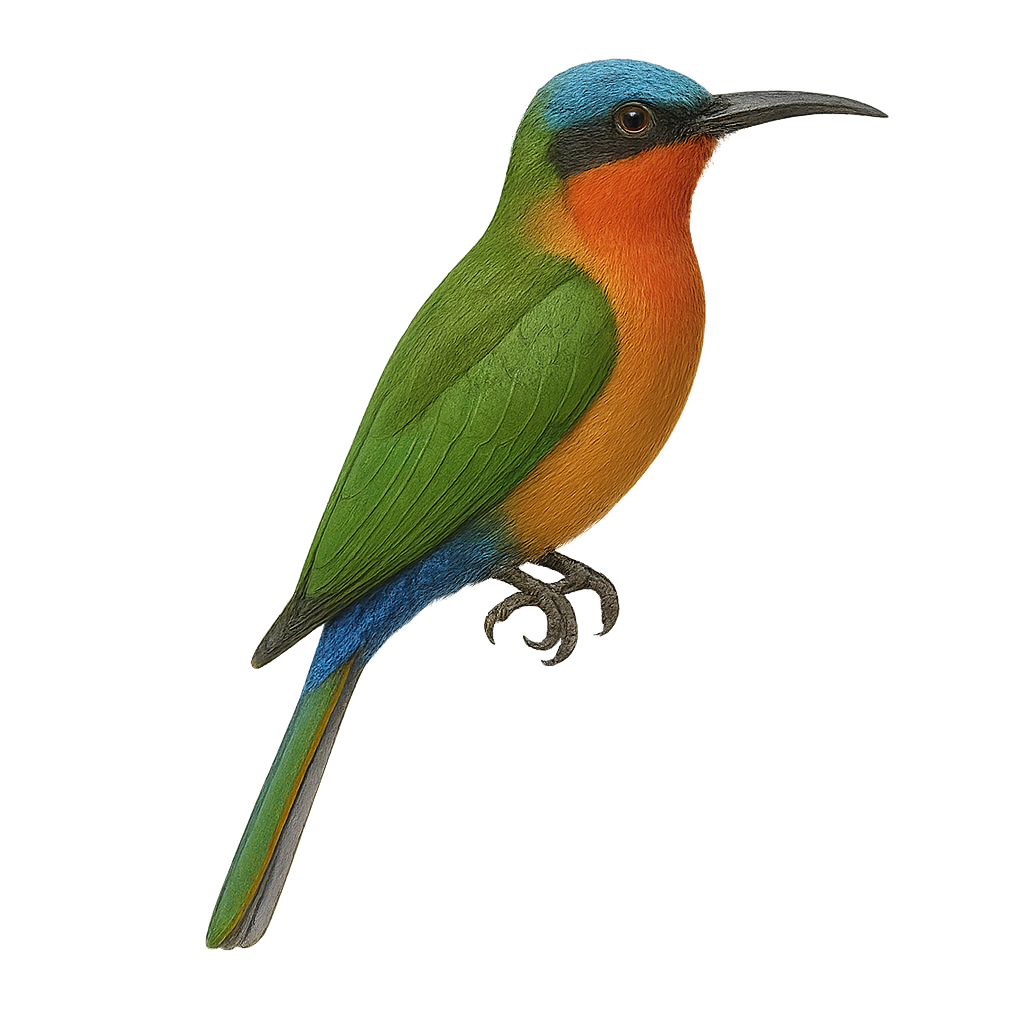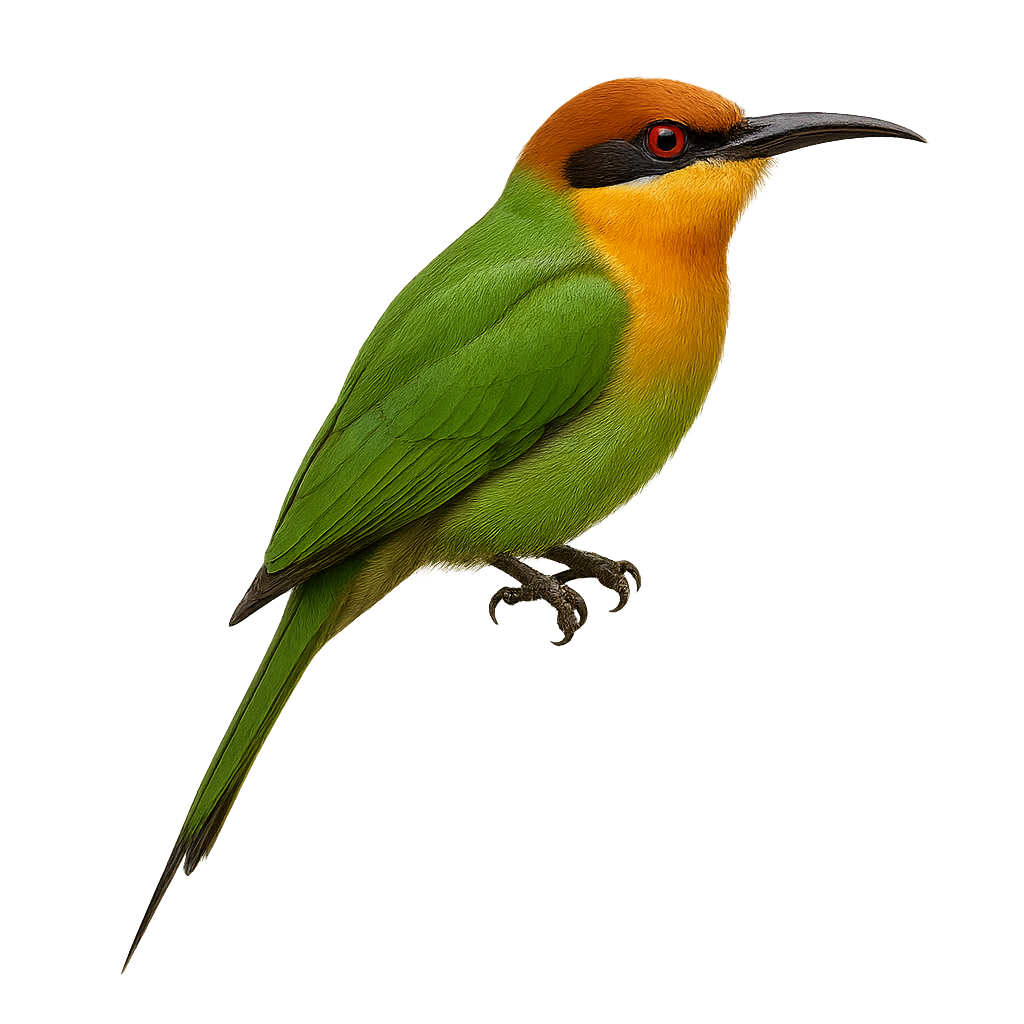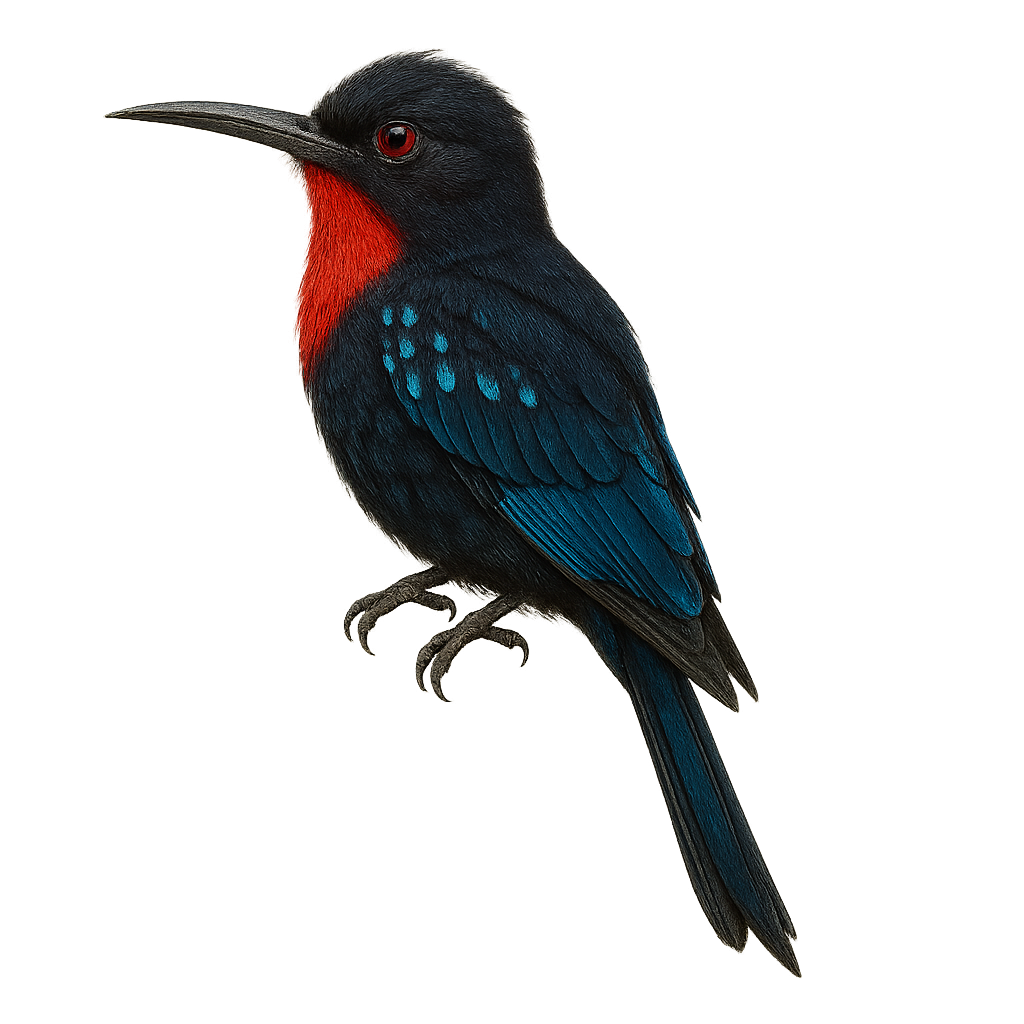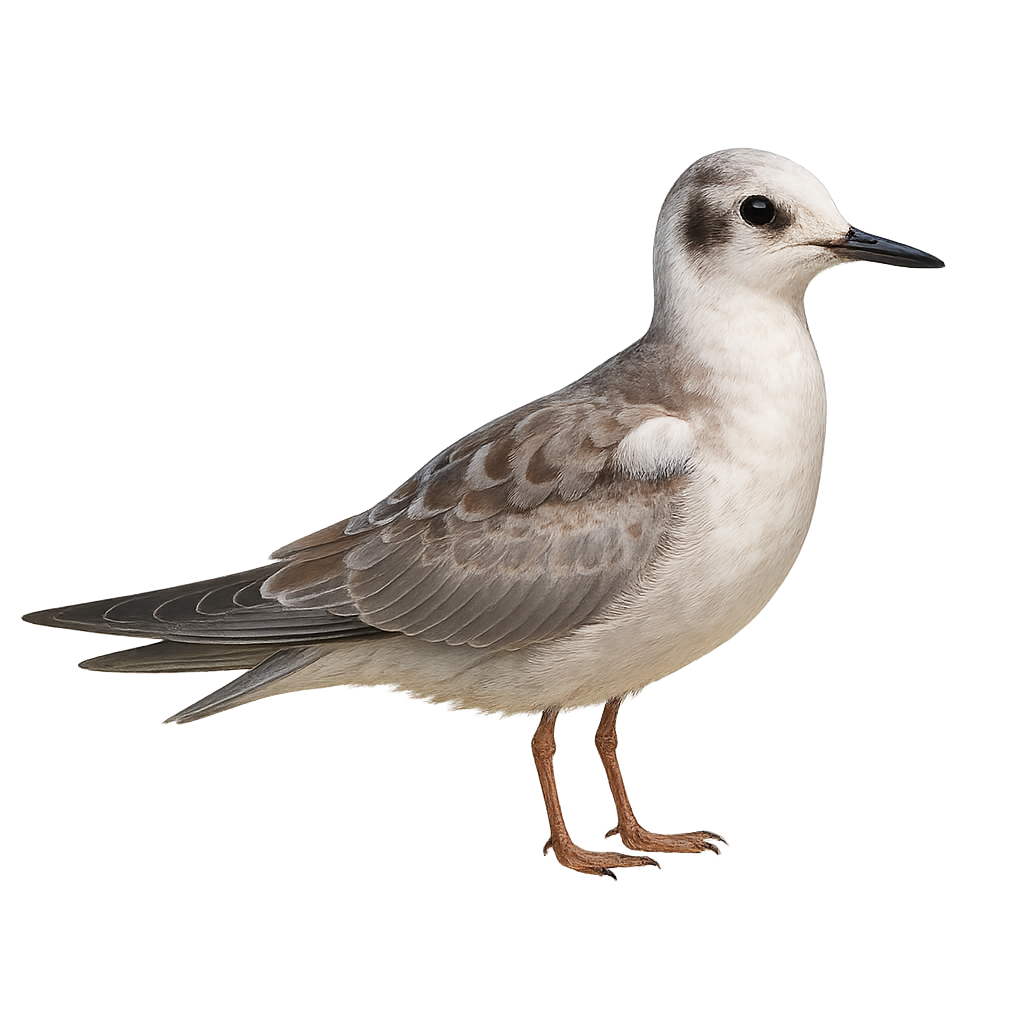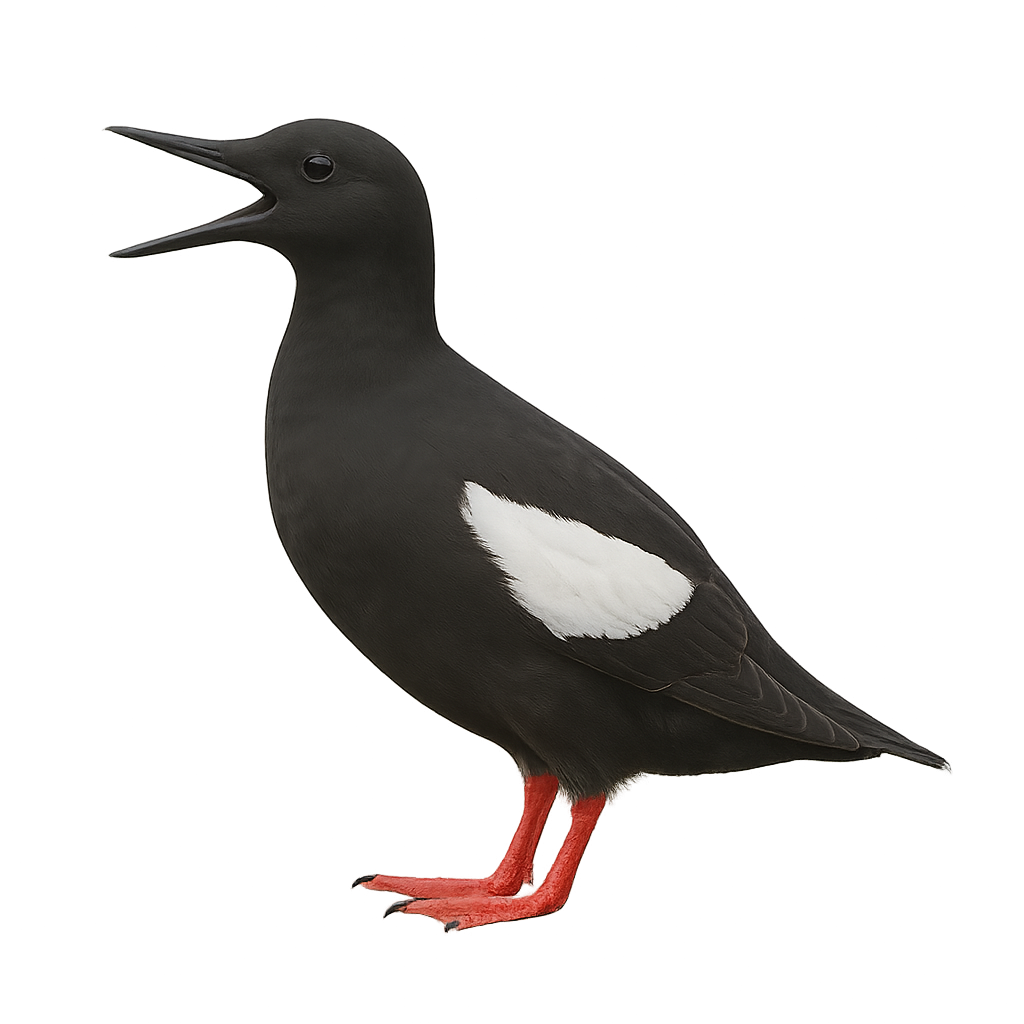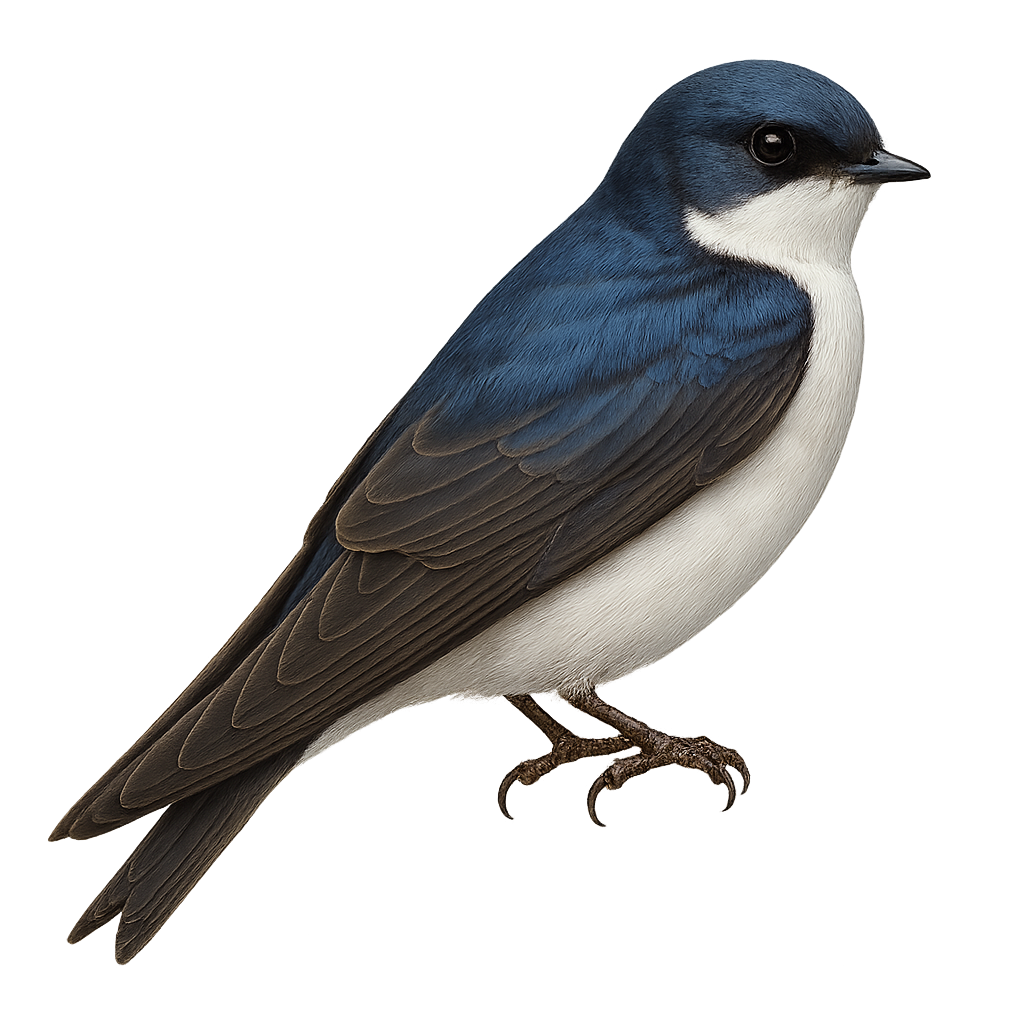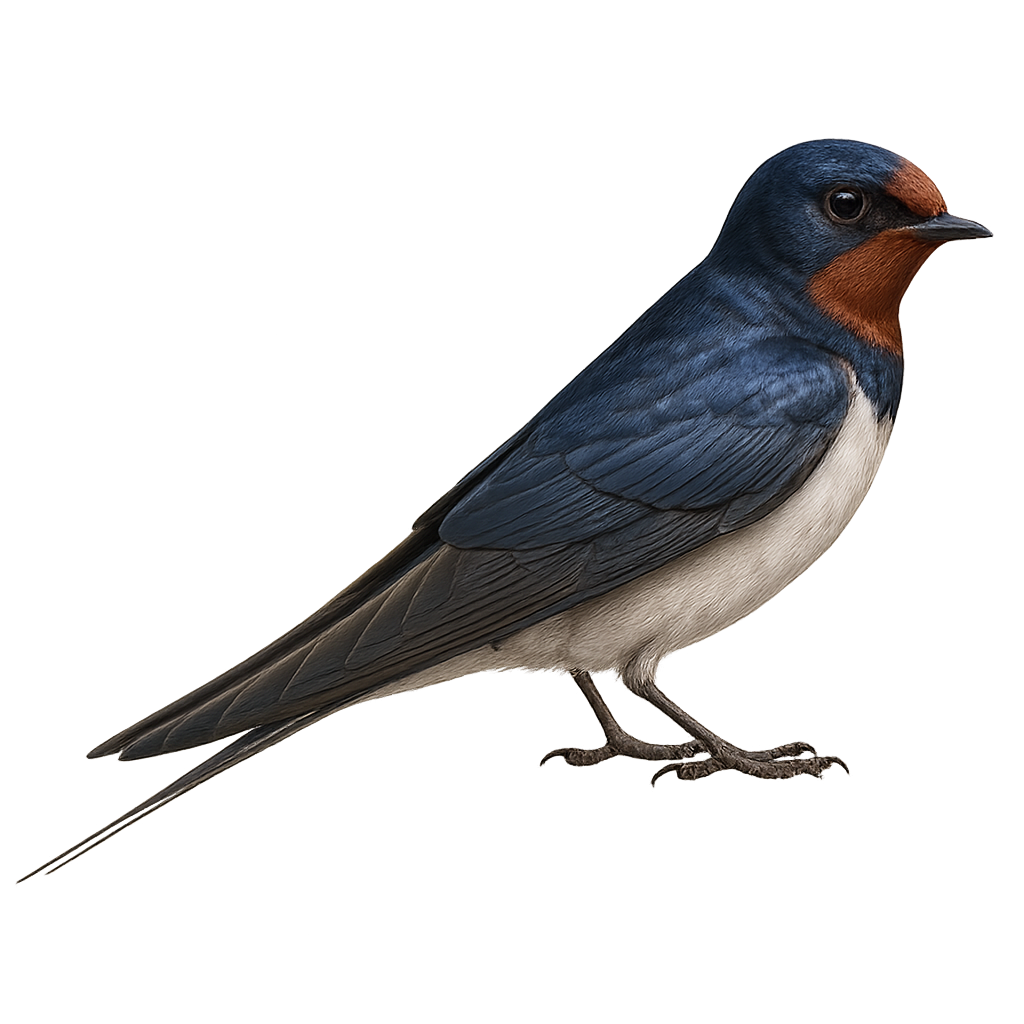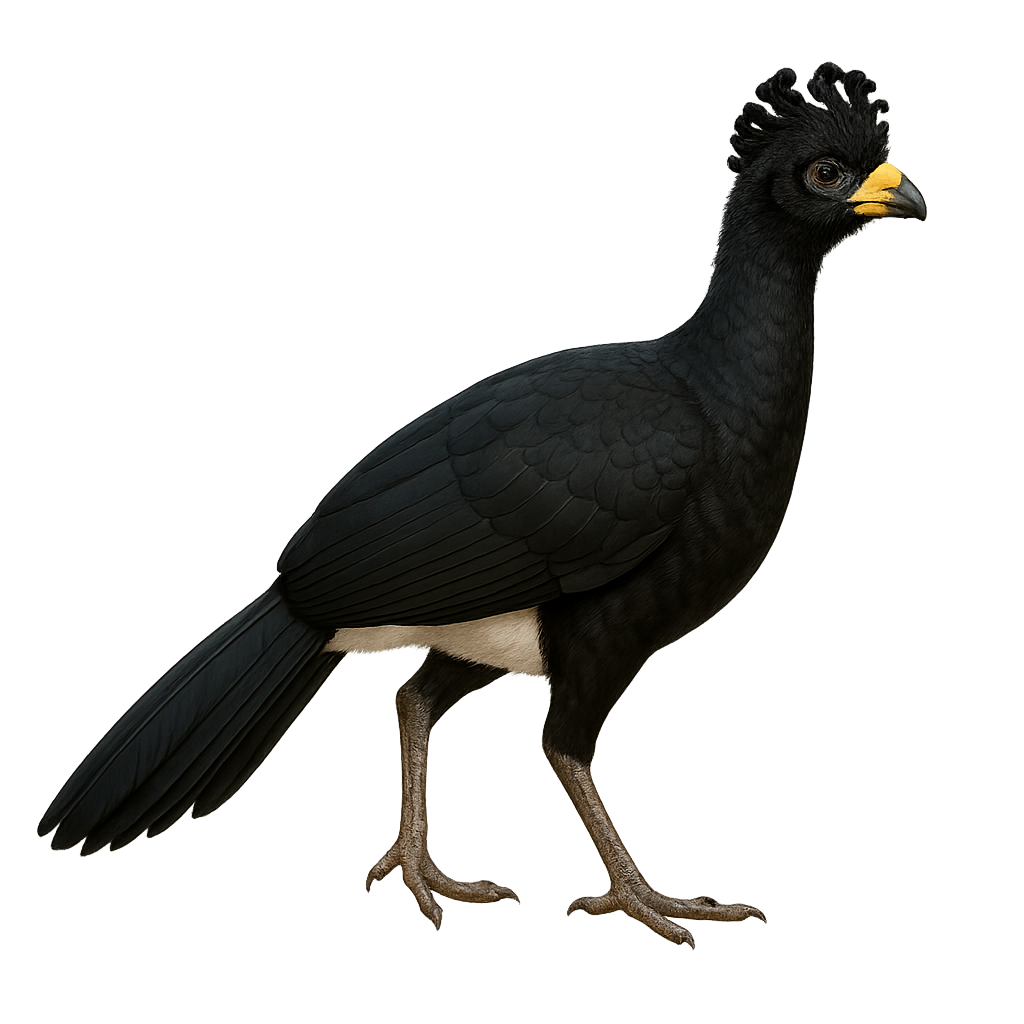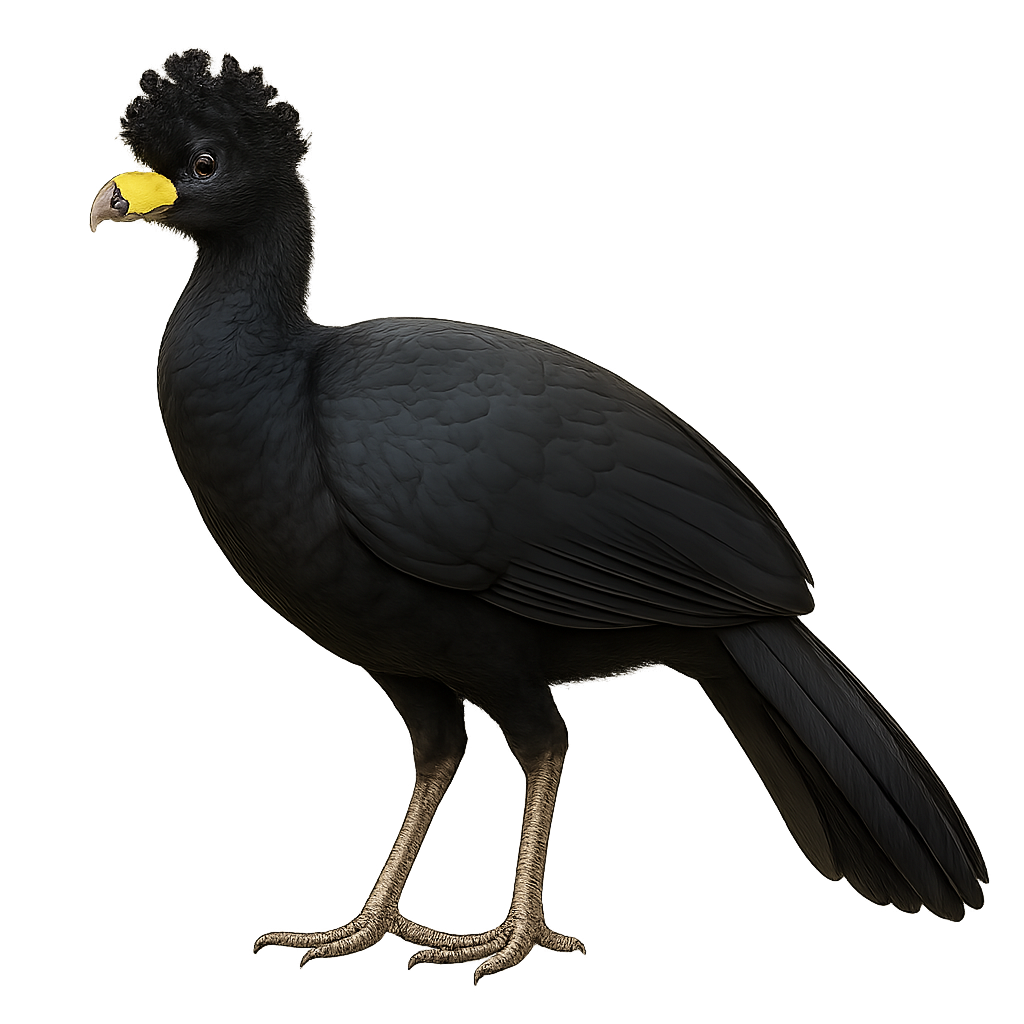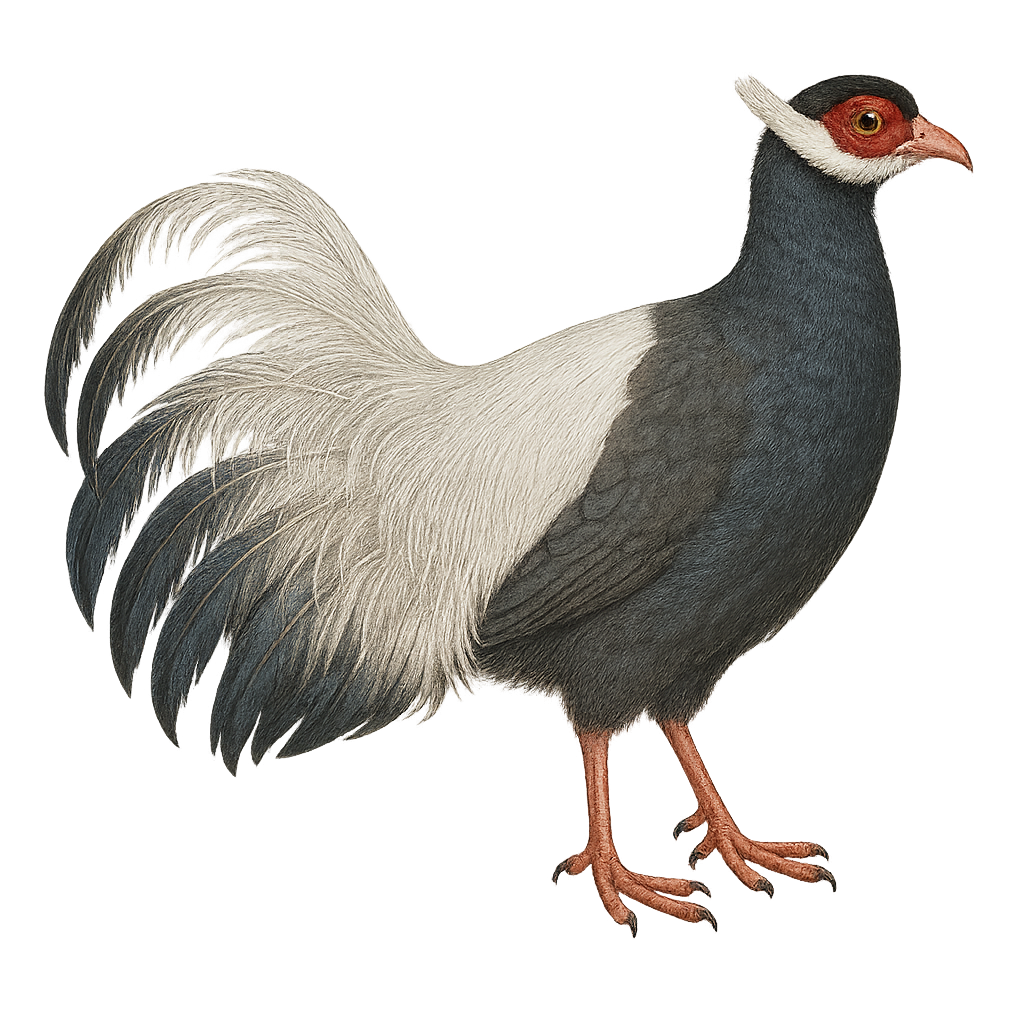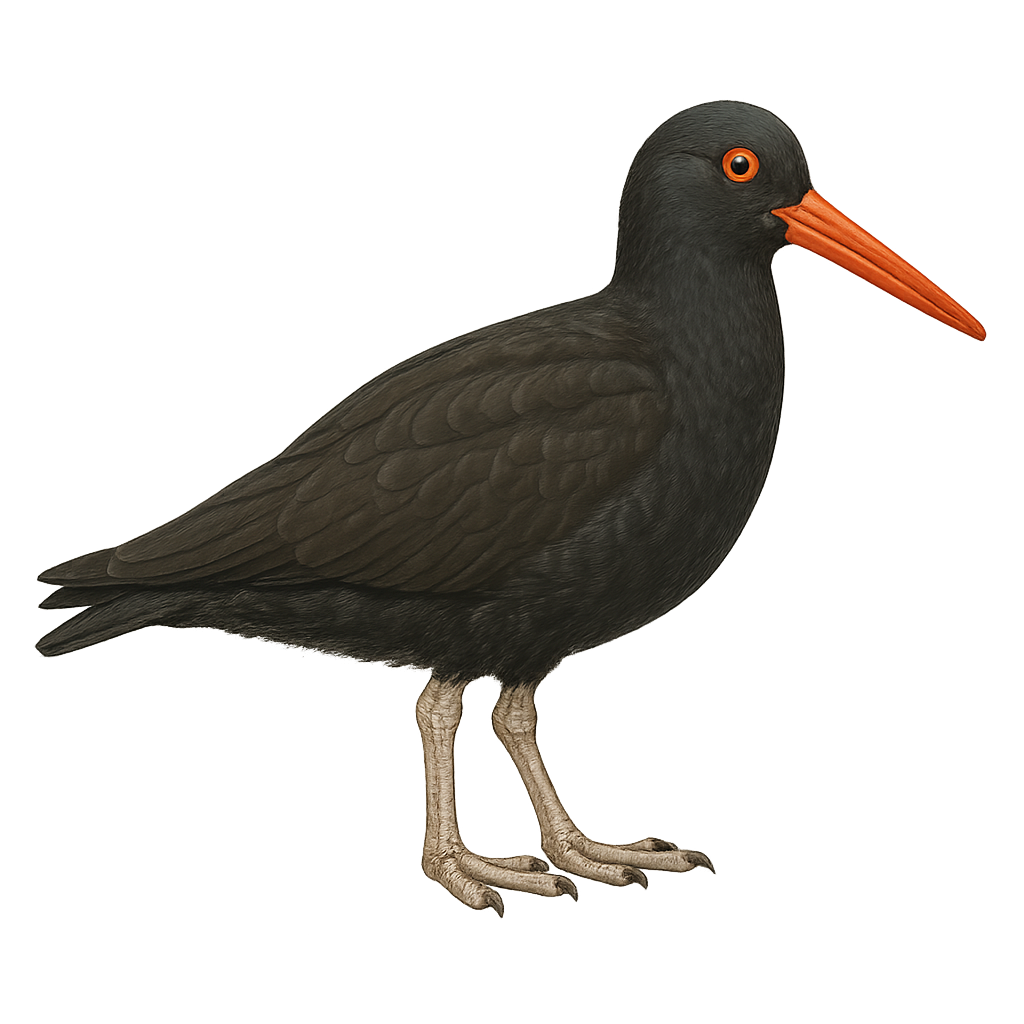The Baer's Pochard, or Aythya baeri, is a rare and endangered diving duck native to East Asia. It is primarily found in China, Russia, and North Korea. This medium-sized duck, measuring about 41 to 46 cm in length, is characterized by its dark brown plumage, black head and neck, and white belly. Males have a striking red iris, while females have a brown iris. The Baer's Pochard prefers freshwater lakes, marshes, and ponds, where it feeds on aquatic plants, insects, and small mollusks. Unfortunately, habitat destruction and excessive hunting have led to a drastic decline in its population, classifying it as critically endangered by the IUCN.
The Pterocles decoratus, commonly known as the Black-faced Sandgrouse, is a medium-sized bird belonging to the Pteroclidae family. It is primarily found in the arid and semi-arid regions of East Africa, particularly in Kenya and Tanzania. This bird is distinguished by its cryptic plumage, which allows it to blend into its sandy environment. Males feature a characteristic black face, contrasting with the rest of their brown and beige plumage. Females are duller, providing additional camouflage during nesting. Black-faced Sandgrouse primarily feed on seeds and are often observed in groups near water sources, especially at dawn and dusk.
The Pterocles orientalis, or black-bellied sandgrouse, is a medium-sized bird known for its cryptic plumage that blends seamlessly into arid landscapes. Males feature a distinctive black belly, contrasting with their sandy-brown plumage. Females are duller, providing effective camouflage during nesting. This bird is primarily terrestrial, feeding on seeds and dry vegetation. It is often seen in flocks, especially around water sources at dawn and dusk. Its flight is swift and direct, often accompanied by noisy wingbeats.
The Barrow's Goldeneye is a medium-sized diving duck, easily identifiable by its rounded head and distinctive black and white plumage. Males have a black head with purple iridescence and bright yellow eyes, while females have a chocolate-brown head with a white eye ring. They breed primarily in the northern regions of North America and Iceland, favoring lakes and rivers bordered by forests. In winter, they migrate to milder coastal waters. Their diet mainly consists of mollusks, crustaceans, and aquatic insects. Although they are relatively tolerant, they can be suspicious of humans.
The Blue Jay, Cyanocitta cristata, is a striking bird with predominantly blue plumage accented with white and black. Easily recognizable by its distinctive crest and loud call, this bird is omnivorous, feeding on seeds, insects, and occasionally small vertebrates. It is commonly found in deciduous and mixed forests, as well as urban parks and gardens. Known for its intelligence, the Blue Jay can mimic sounds, including the calls of other birds. It plays a crucial role in seed dispersal, aiding forest regeneration.
The Brown Jay, or Cyanocorax morio, is a bird from the Corvidae family, primarily found in Central America. It is characterized by its dark brown plumage, contrasting with lighter wings and tail. Its head features a black mask around the eyes and a strong beak. This sociable bird lives in family groups and is often seen in tropical forests, mangroves, and open woodlands. Opportunistic, it feeds on fruits, insects, and sometimes small vertebrates. Its call is loud and varied, used to communicate with its peers. The Brown Jay plays a crucial role in seed dispersal, aiding forest regeneration.
The Black-winged Pratincole, Glareola nordmanni, is a medium-sized migratory bird belonging to the Glareolidae family. It is recognizable by its light brown plumage, black wings, and forked tail. This bird is known for its ability to fly rapidly and perform impressive aerial acrobatics to catch insects in flight. It is primarily found in the steppes and open grasslands of Eastern Europe and Central Asia. The Black-winged Pratincole migrates to sub-Saharan Africa for the winter. It nests on the ground, often in loose colonies, and prefers habitats near water. Although its conservation status is concerning due to habitat loss, it remains relatively widespread in some regions.
The Laniarius erythrogaster, commonly known as the Black-headed Gonolek, is a striking bird with vivid red underparts and a black head and back. It primarily inhabits the savannas and open forests of sub-Saharan Africa. This bird is often seen in pairs, producing melodious duets. It measures about 20 cm in length and feeds mainly on insects and small invertebrates. Although relatively discreet, its distinctive song makes it easier to spot. It plays a crucial role in the ecosystem by controlling insect populations.
The Bluethroat is a small songbird, easily recognizable by its bright blue throat, bordered by a black band, forming a distinctive "mirror" pattern. It measures about 13 to 14 cm in length, with a wingspan of 22 to 25 cm, and weighs around 15 to 20 g. Its plumage is generally brownish on the back and light on the belly, with white and orange markings on the sides of its chest. The Bluethroat is primarily found in marshy areas, shrublands, and riverbanks in Europe and Central Asia, although some populations migrate to North Africa during the winter. It is especially known for its melodious song, which is often heard during the breeding season. The species primarily feeds on insects, worms, and small berries. While the Bluethroat is not endangered, it faces risks related to the loss of its natural habitat and changes in wetland areas.
The Black Crowned Crane, Balearica pavonina, is a majestic and iconic bird of the wetlands in West and Central Africa. It is distinguished by its golden crown of stiff feathers and predominantly grey plumage. Its face features white and red cheeks, and it has a short, black beak. Standing about one meter tall and weighing between 3 and 4 kg, this gregarious bird is often seen in pairs or small groups, feeding on seeds, insects, and small vertebrates. The Black Crowned Crane is renowned for its spectacular courtship displays, performing complex dances with jumps and wing flaps.
The Blue-bearded Bee-eater, or Nyctyornis athertoni, is a fascinating bird known for its striking plumage and distinctive blue beard. It primarily inhabits the tropical and subtropical forests of Southeast Asia, particularly in India, Bangladesh, and Thailand. This bird measures about 30 to 35 cm in length and primarily feeds on insects, especially bees and wasps, which it catches in flight with its robust and slightly curved beak. The Blue-bearded Bee-eater is a diurnal bird, often observed alone or in pairs, and is known for its agile and swift flight. Although relatively tolerant of human presence, it prefers dense wooded areas where it can hide and feed in peace.
The Blue-breasted Bee-eater, or Merops variegatus, is a colorful and fascinating bird belonging to the Meropidae family. It boasts a vibrant plumage with shades of green, blue, and brown, and a bright blue breast that gives it a distinctive appearance. This bee-eater is often observed in savannas, open forests, and wooded areas of sub-Saharan Africa. It primarily feeds on flying insects, especially bees and wasps, which it catches in flight with remarkable agility. The Blue-breasted Bee-eater is a sociable bird, often seen in small groups, and is known for its spectacular courtship displays. Although its conservation status is currently stable, deforestation and habitat loss could pose future threats.
The Blue-throated Bee-eater, Merops viridis, is a colorful and fascinating bird known for its vibrant plumage and captivating social behaviors. It sports bright green feathers, with a blue throat and wings in shades of brown and blue. This bird is often observed in Southeast Asia, particularly in tropical forests and open wooded areas. It primarily feeds on flying insects, especially bees and wasps, which it catches in flight with remarkable agility. The Blue-throated Bee-eater is a sociable bird, often seen in groups, and is known for its spectacular courtship displays. Its breeding season varies by region but is generally active during the warmer months.
The Bullock's Bee-eater, or Merops bullocki, is a colorful and fascinating bird belonging to the Meropidae family. This bee-eater is distinguished by its vibrant plumage, combining shades of green, blue, and yellow, with an often orange throat. It is mainly observed in wooded regions and open savannas of sub-Saharan Africa. This bird is known for its specialized feeding habits, primarily consuming flying insects, particularly bees and wasps, which it captures in flight with its aerial hunting techniques. The Bullock's Bee-eater is a social bird, often seen in small groups, and is renowned for its spectacular courtship displays. Although not considered threatened, deforestation and habitat loss could affect its populations in the long term.
The Black-headed Bee-eater, or Merops mentalis, is a small and discreet bee-eater found in West and Central Africa, typically in open woodlands and forest edges. It is identified by its bright green plumage, turquoise-blue belly, and distinct white throat bordered by black “moustache” markings. Its slender black bill is slightly curved downward. This species is usually seen in pairs or small groups, perched openly while hunting flying insects, especially bees and dragonflies. Although little known outside its range, the Black-headed Bee-eater remains relatively common in undisturbed habitats.
The Blue-tailed Bee-eater, Merops philippinus, is a colorful and graceful bird belonging to the Meropidae family. This bee-eater is distinguished by its vibrant plumage, predominantly green with a bright yellow throat and turquoise blue tail. It is often seen in Southeast Asia, particularly in open areas near water, where it hunts insects in flight. Known for its acrobatic flights and melodious song, it nests in burrows dug into sandy banks. Although sociable, it remains wary of humans. Its population is stable, but it is sensitive to environmental changes.
The Blue-headed Bee-eater, or Merops muelleri, is a captivating bird belonging to the Meropidae family. This bee-eater is distinguished by its bright blue head, green back, and rufous chest, creating a striking contrast. It is primarily found in the dense tropical forests of Central Africa, notably in Cameroon, the Central African Republic, and the Democratic Republic of the Congo. This bee-eater is a specialized insectivore, feeding mainly on bees and wasps, which it catches in flight with agile aerial maneuvers. The Blue-headed Bee-eater is a social bird, often seen in small groups. Its breeding period is poorly documented, but it is known to nest in burrows dug into sandy banks. Although its conservation status is currently assessed as "least concern," deforestation poses a potential threat to its natural habitat.
The Black-headed Bee-eater, or Merops breweri, is a colorful and fascinating bird primarily found in the tropical forests of Central Africa. It is distinguished by its black head contrasting with its bright green body and white throat. This bee-eater is a specialized insectivore, feeding mainly on bees and wasps, which it catches in flight thanks to its agility and speed. It lives in small family groups and is known for its complex social behaviors, including food sharing and cooperative territory defense. Although its habitat is threatened by deforestation, it is currently classified as "least concern" by the IUCN.
The Boehm's Bee-eater, or Merops boehmi, is a colorful and fascinating bird, primarily found in the wooded regions and savannas of Central and East Africa. It is distinguished by its vibrant plumage, blending shades of green, blue, and yellow, with a long, tapered tail. This bee-eater is a specialized insectivore, feeding mainly on bees and other flying insects, which it skillfully captures in flight. Sociable by nature, it often lives in small colonies and nests in burrows dug into sandy banks. Its melodious song and aerial acrobatics make it a captivating sight for nature observers.
The Blue-cheeked Bee-eater, or Merops persicus, is a strikingly colorful bird known for its vivid green plumage, blue throat, and distinctive black eye stripe. Measuring about 28 to 30 cm in length, it features long, pointed wings and a forked tail. This migratory bird primarily feeds on flying insects, especially bees, wasps, and dragonflies, which it catches in flight with remarkable agility. It inhabits open areas, savannas, and riverbanks, often seen in groups. During the breeding season, it digs burrows in sandy banks for nesting. The Blue-cheeked Bee-eater is a fascinating sight for birdwatchers and nature enthusiasts.
The Black-headed Bee-eater, Merops gularis, is a fascinating bird belonging to the Meropidae family. This bee-eater is distinguished by its black head contrasting with its bright red throat and vibrant green plumage. It is primarily found in the humid tropical forests of West Africa, where it feeds mainly on flying insects, particularly bees and wasps. Its flight is agile and swift, allowing it to catch prey mid-air. Although its habitat is relatively stable, deforestation poses a threat to its population. The Black-headed Bee-eater is a sociable bird, often seen in small groups, and is known for its melodious and varied vocalizations.
The black tern is a small tern of 23–26 cm with contrasting black and white breeding plumage and a slender body. It inhabits freshwater wetlands, marshes and shallow lakes, feeding on insects and small fish caught in flight by pattering over the water surface. During breeding, it nests on floating vegetation, lays 2–4 eggs and defends its territory with swift aerial displays and sharp calls.
The Black Guillemot is a medium-sized seabird, measuring between 32 and 38 cm in length with a wingspan of 49 to 58 cm. In breeding plumage, it has a black body with a large white wing patch, bright red feet, and a red interior to its bill. In winter, its plumage becomes paler, with a light grey back and head and white underparts. It inhabits rocky coasts of the North Atlantic and Arctic, nesting in crevices of cliffs or under rocks. Its diet mainly consists of fish, crustaceans, and mollusks, which it captures by diving up to 50 meters deep. Although listed as Least Concern by the IUCN, it is sensitive to marine pollution and predation by introduced species.
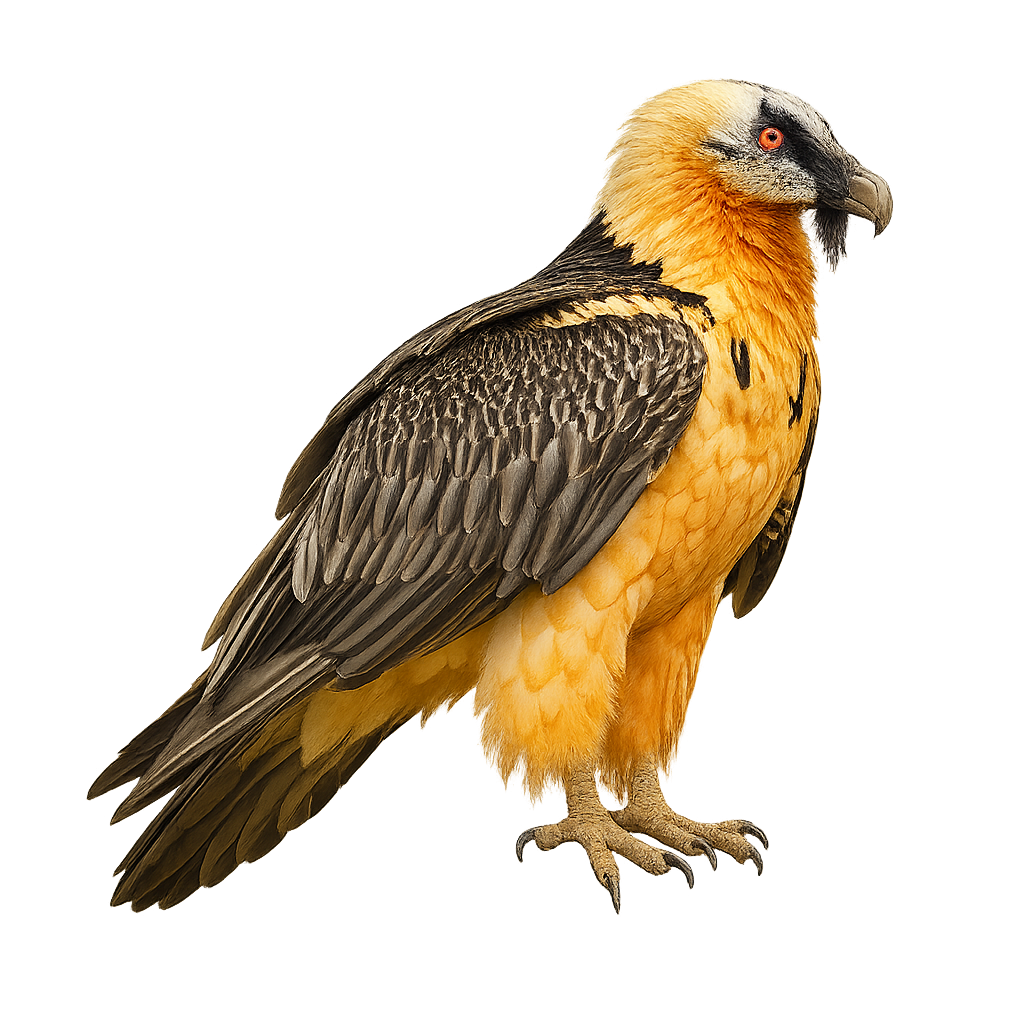
The Bearded Vulture is a large vulture, easily recognizable by its distinctive head, large wings, and brown and white plumage. It measures about 1.1 to 1.3 meters in length, with a wingspan of 2.6 to 2.8 meters, and weighs between 4.5 and 7.5 kg. Its head is covered with dark feathers, while its wings and back are mainly brown, with lighter feathers on its belly. The Bearded Vulture is unique among vultures for its feeding behavior, as it primarily feeds on bones. It is capable of breaking the hardest bones by dropping them from great heights to shatter them, allowing it to access the bone marrow. It primarily inhabits mountains, notably the Alps, the Pyrenees, and the Himalayas, where it also feeds on carcasses of dead animals, such as chamois or mouflons. Although the species was once endangered, conservation efforts have helped restore its population in certain areas. However, the Bearded Vulture remains vulnerable to human disturbance, habitat loss, and the decline of its natural prey.
The Blue-and-white Swallow, or Pygochelidon cyanoleuca, is a small, agile bird easily recognized by its metallic blue back and white belly. It frequents open areas, often near water, where it skillfully hunts flying insects. This species is widespread in South America, from Panama to Argentina. It is often seen in groups, especially outside the breeding season. Nests are typically built in natural or artificial cavities, such as bridges or buildings. Although its conservation status is currently "least concern," it is sensitive to environmental changes, particularly pollution and habitat destruction.
The barn swallow is a small migratory bird found primarily in Europe, Asia, and Africa. It is easily recognizable by its metallic blue back, pointed wings, and deeply forked tail. This bird is often seen flying at high speeds, hunting insects which it catches mid-flight. The barn swallow builds its nest under roofs, in barns, or buildings, and undertakes an impressive long migration each year.
The Bare-faced Curassow is a large terrestrial bird from the Cracidae family, primarily found in the tropical forests of South America, including Brazil, Bolivia, Paraguay, and Argentina. It is easily recognizable by its glossy black plumage in males, with a bright yellow bare face, while females have brown plumage with barred patterns. This bird prefers dense forest habitats where it feeds mainly on fruits, seeds, and insects. Although capable of flight, it spends most of its time on the ground. The Bare-faced Curassow is threatened by deforestation and hunting, leading to population declines in some areas.
The Crax alector, commonly known as the Black Curassow, is a large bird from the Cracidae family, native to the tropical forests of South America. It is easily recognizable by its glossy black plumage and distinctive curly crest. Males have a bright yellow beak, while females display more subdued patterns. This bird prefers dense forest habitats where it primarily feeds on fruits, seeds, and insects. Although capable of flight, it spends most of its time on the ground. The Black Curassow plays a crucial role in seed dispersal, aiding in forest regeneration. Unfortunately, it is threatened by deforestation and excessive hunting, leading to population declines in some areas.
The Brown Eared Pheasant, or Crossoptilon mantchuricum, is a fascinating bird native to the mountainous forests of China. This pheasant is distinguished by its long white ear tufts, which give it its name. Its plumage is primarily brown with metallic sheens, and it boasts an impressive tail. Males and females are similar, although males are slightly larger. They live in family groups and are known for their complex social behavior. Their diet mainly consists of seeds, roots, and insects. Unfortunately, this species is threatened by habitat loss and hunting. Conservation efforts are underway to protect these majestic birds and their environment.
The Black Oystercatcher is a distinctive coastal bird, recognizable by its black plumage and long red-orange bill. It primarily inhabits the rocky coasts of the North Pacific, from Alaska to California. This bird is often seen foraging for mollusks and crustaceans, which it skillfully opens with its powerful bill. Although its appearance is understated, its loud and piercing call is easily identifiable. The Black Oystercatcher is monogamous and vigorously defends its territory during the breeding season. Pairs often nest on rocky islets, where they typically lay two to three eggs. Despite its wide distribution, it is sensitive to human disturbances and environmental changes, making it a species to watch.


